Richard Stuart-Turner reports on the latest hardware developments in the thriving digital textile printing market.
Constantly talked up over the last few years as one of the most promising areas of large-format, digital textile printing requires little introduction. The sector is experiencing major growth - particularly in the areas of soft signage, fashion and home textiles - as the demand for personalised goods continues to take hold, and there is no sign of things slowing down.
According to Smithers Pira, a total of 870m m2 of fabric were printed on digital equipment in 2016 - worth $1.29bn (£940m) - and this volume will increase at an average annual rate of 17.5% in the years up to 2021, consuming nearly 1.95bn m2 in that year and equating to a market value of $2.66bn.
With such a positive outlook for the market, the most recent European Fespa show, held in Hamburg last May, was unsurprisingly awash with new textile technologies and we can expect to see another raft of developments at the 2018 event, which will take place at Messe Berlin from 15 to 18 May.
As a warm-up of sorts, January saw the 2018 version of Heimtextil, the international textile and garment manufacturing trade fair held annually in Frankfurt. While new printer launches at the show were thin on the ground, there were plenty of hints as to where the market is heading.
HP had one machine running on its stand - the Latex 570 - but the company made a conscious decision to focus less on hardware this year.
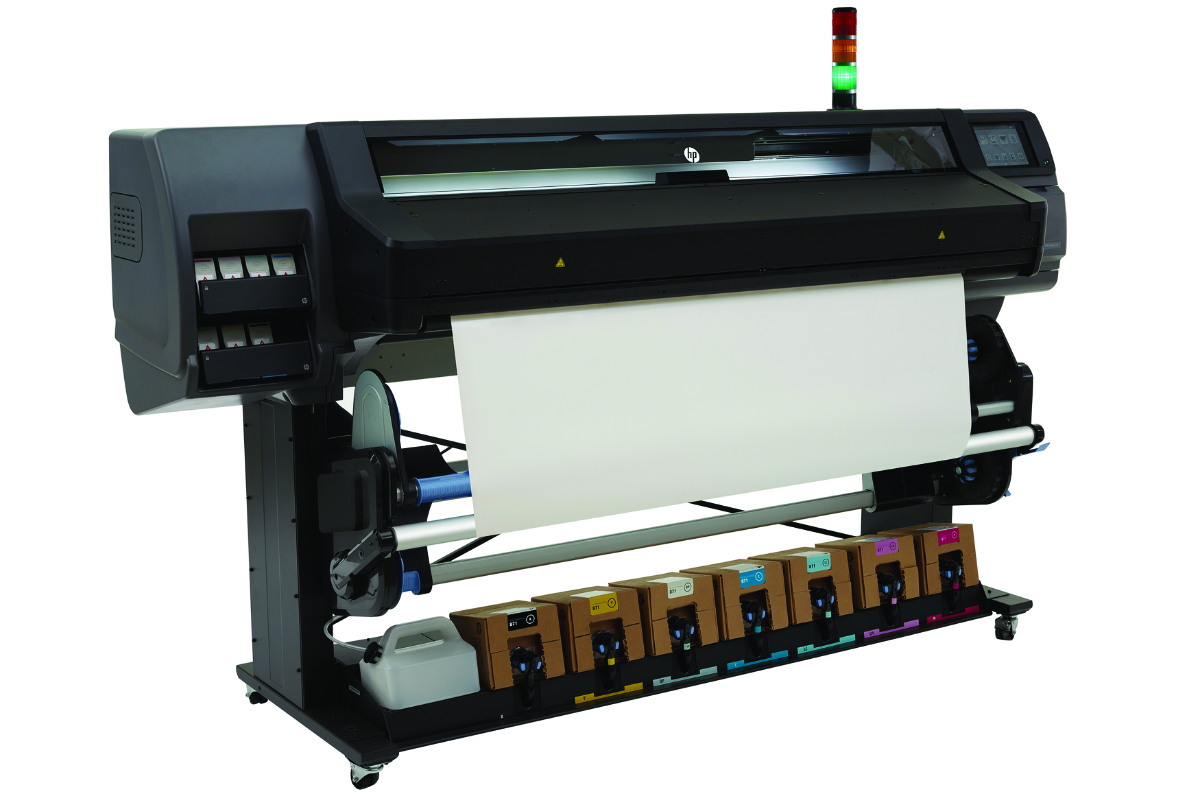
“We were trying to move away from showing the oven - it’s more important to show what comes out of it, and so our Heimtextil stand was really about showing applications,” says HP business development manager for printed decorative applications, Terry Raghunath.
HP has continued to update its Latex portfolio, adding two mid-range 3.2m-wide options in the past few months - the Latex 3600 and 3200. Both machines are able to print textiles and canvas at speeds of up to 44m2/hr.
“The textile market is a huge opportunity and whoever is not sniffing there is probably missing the point. Our Achilles heal has always been the washability with the inks, but there are more and more textile materials that we can start to use now,” says Raghunath.
“The Latex technology has been gaining a lot of awareness and has become a reference on the market, so as it has been gaining more penetration, media manufacturers have been waking up to the fact that they need to develop media for this technology - we’re seeing this in wallcoverings, window blinds and many other applications that we’re going after.”
The company will also broaden its textile printing horizon in the coming years, according to Mike Horsten, HP Graphics Solutions Business EMEA sales manager for large-format graphic production. “There is a very high push from our senior management to open up textiles beyond Latex,” he says. “Today our focus is Latex, which is going to protect us for the long-term, but there will be different technologies coming online.”
HP was running wallcovering printing demos on its Latex 570 at Heimtextil and was far from the only exhibitor concentrating on this area. Industrial Inkjet (IIJ) for instance, used the show to update wallpaper manufacturers on its digital wallpaper printing system, following more than two years of R&D with partner Konica Minolta.
The firm says this system will compete with conventional printing methods in terms of productivity and cost-per roll and can print on media including paper, PVC and non-woven - coated and uncoated - at high speed. There are no restrictions on image length and mural-wall images can be printed back-to-back without a gap.
Mimaki showed a range of kit at Heimtextil, including its Tx300P-1800 - highlighting the machine’s dual ink capability by demonstrating both dye-sub onto polyester and pigment onto natural fabrics using the same device. It also demonstrated the Tx300P-1800B, showing how the belt option adds the stability needed for printing onto stretch and lightweight materials.
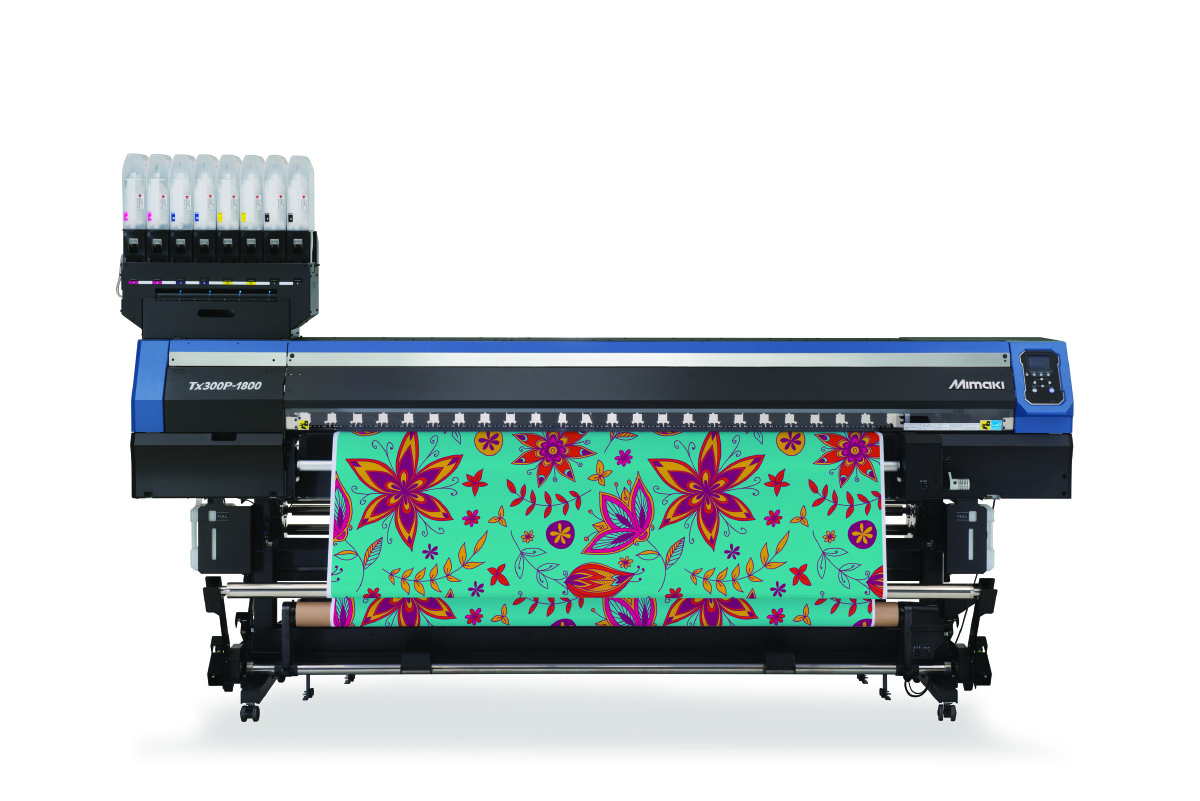
“The advancements that Mimaki has made over the last few years has ensured that print quality and speeds are constantly improving. Another major development is that we are consistently seeing running costs coming down,” says Brett Platt, textile product manager at Mimaki distributor Hybrid Services.
Platt says one of the main reasons the home textile market is growing so quickly is recent advancements in pigment ink technology.
“Historically, natural fabrics could only be printed with reactive inks, which require steaming and washing to finish. However, advanced pigment ink technology only requires heat to fix and the process is far easier. From an investment point of view, the development of pigment inks have meant that you don’t need a factory with a steamer or a wash line to produce high quality textiles.”
Furthermore, Platt adds advancements in polyester fabrics are enabling PSPs to more easily branch out into the production of soft signage, sportswear and home interiors with an entry-level sublimation transfer printer.
“Making the transition into sublimation transfer printing is an easy move as the media handling of transfer paper is very similar to that of general signage substrates. The handling of natural fabrics is more complicated than transfer paper, however Mimaki machines such as the Tx300P-1800B are designed to keep media stable.”
High on Durst’s list of priorities is the continual development of its Alpha Series printers and Alpha Ink P, the one-step pigment ink it has developed especially for these machines.
“Standard materials such as cotton and polyester do not require pre- and post-treatment with this ink, so the entire digital production process is accelerated and simplified,” says Durst textile printing segment manager, Martin Winkler.
“The Durst Alpha Series features different configurations and print widths for industrial printing of fashion garment and apparel, home textiles and upholstery. This efficient and economic digital textile production has step-less quality up to 1,450m2/hr.
At Fespa last year, Durst marked the European show debut of its 3.2m-wide Rhotex 325 printer, which Winkler says has been “extremely well received in the market”. “One of its incredible benefits is featuring the dual properties of direct-to-textile and printing on transfer paper.”
For PSPs looking to print wider, a significant recent development came from ATPColor, which last year debuted what it claims is the world’s first 5.3m-wide grand-format textile printer with integrated inline fixation. This one-step process means users do not need to load and unload both the printer and the calender.
Meanwhile, EFI’s latest superwide-format textile addition is the 5.2m-wide Vutek FabriVu 520, which incorporates Reggiani technology. This machine can print at up to 446m2/hr, with a resolution up to 2,400dpi, and is suitable for producing items including banners, flags, backlit displays and wall murals. EFI says it can handle both direct-to-textile and transfer printing with an easy changeover using the same inkset.
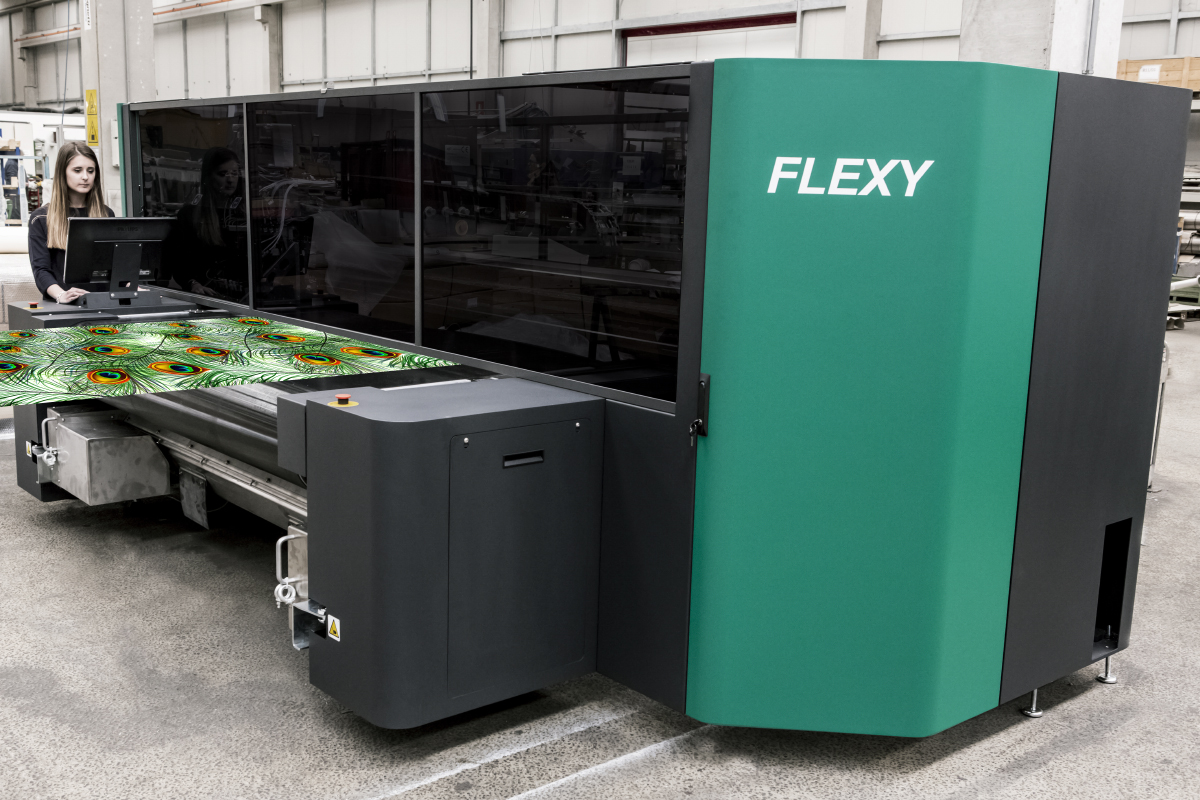
More recently the manufacturer, which showed printed samples rather than machinery at Heimtextil, has launched the smaller Reggiani Renoir Flexy, a 1.8m-wide machine capable of printing at up to 400m2/hr with a resolution of up to 2,400dpi. This printer can handle fabrics ranging from knitted to woven as well as low- and high-stretchable materials.
“The Flexy can be used for sampling and small production. It was created for the entry-level segment of the garment market,” says EFI Reggiani sales and marketing director, Michele Riva.
EFI has also just launched its Fiery Textile Bundle, a set of design and production workflow innovations for the Reggiani machinery. The bundle includes new Fiery DesignPro Adobe Illustrator and Photoshop plug-ins, to enable users to create professional textile designs efficiently, as well as version 6.5 of the Fiery proServer digital front-end.
The company says version 6.5 is an advanced offering for use with wide- and superwide-format printers that offers high-quality textile production, with support for multiple ink types and colour technology and the production tools to handle step and repeat, changes in fabric dimensions during production, and brand colour accuracy.
“In 2018 we have a roadmap where we will have new developments in equipment, in chemistry and in the depth of applications possible. In terms of products, we will continue our developments in pigment because this is an area where we believe there is huge potential,” says Riva.
Mutoh showed its ValueJet 1938TX and 1948WX models at Heimtextil. The 1938TX is a 1.9m-wide direct-to-textile printer that can print on closed and open non-stretch and limited stretch fabrics while the 1948WX is an industrial highquality 1.9m-wide dye-sub printer.
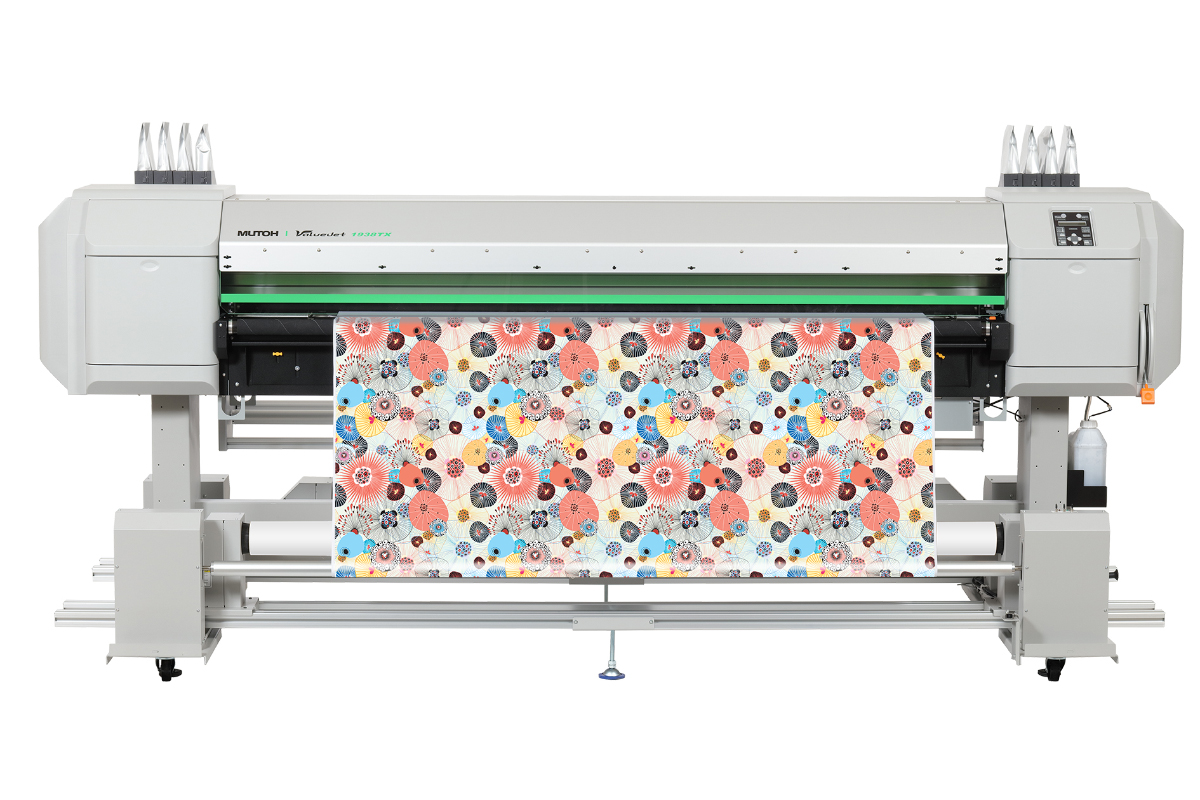
The 1938TX incorporates a newly engineered high-end fabric feeding, tensioning and take-up system which Mutoh says guarantees “worry-free” feeding and transport of fabrics.
Mutoh commercial marketing manager, Nick Decock, says the environmentally friendly nature of textile printing particularly appeals to PSPs and their clients. “The lower production cost versus analogue technologies - no setup cost, even for one-offs - and the environmental comfort - there is no need to clean plates after printing - makes digital print equipment environmentally friendly.”
On the smaller side of the digital textile printing market are the direct-to-garment printers that are generally used for producing promotional items such as t-shirts, hoodies and sweatshirts – add-on applications for so many largeformat PSPs and worth a look here because of that.
Kornit Digital’s recently launched Storm Duo, which runs at a maximum speed of 190 garments per hour, is targeted at light fabric printing, while the company’s Vulcan can print 250 light or dark garments per hour and is developed for mass production and customisation.
While this kit may be ideal for screen printers considering a move to digital, or those dealing with high volumes, there are plenty of alternatives available for PSPs producing shorter runs or just getting started in this area.
Ricoh has just entered the direct-to-garment fray for the first time with two new printers, the Ri 3000 and Ri 6000. These machines, which use Ricoh’s water-based pigment ink, print at speeds of up to 27 seconds per garment.
“The demand for decorated garments is expected to continue to grow as it becomes easier to create and order these items,” says Ricoh Europe head of commercial inkjet business, Graham Kennedy.
“The textile print market is changing - the main important trends are to be able to deliver fast and with no minimum order quantity. This drives the demand for digital print solutions rather than conventional analogue technologies.”
Epson’s direct-to-garment printer the SureColor SCF2000, which prints onto a wide range of cotton or cotton blend products, is well established on the market. The company says its future developments in this area will focus on more automated maintenance and a lower cost of ownership.
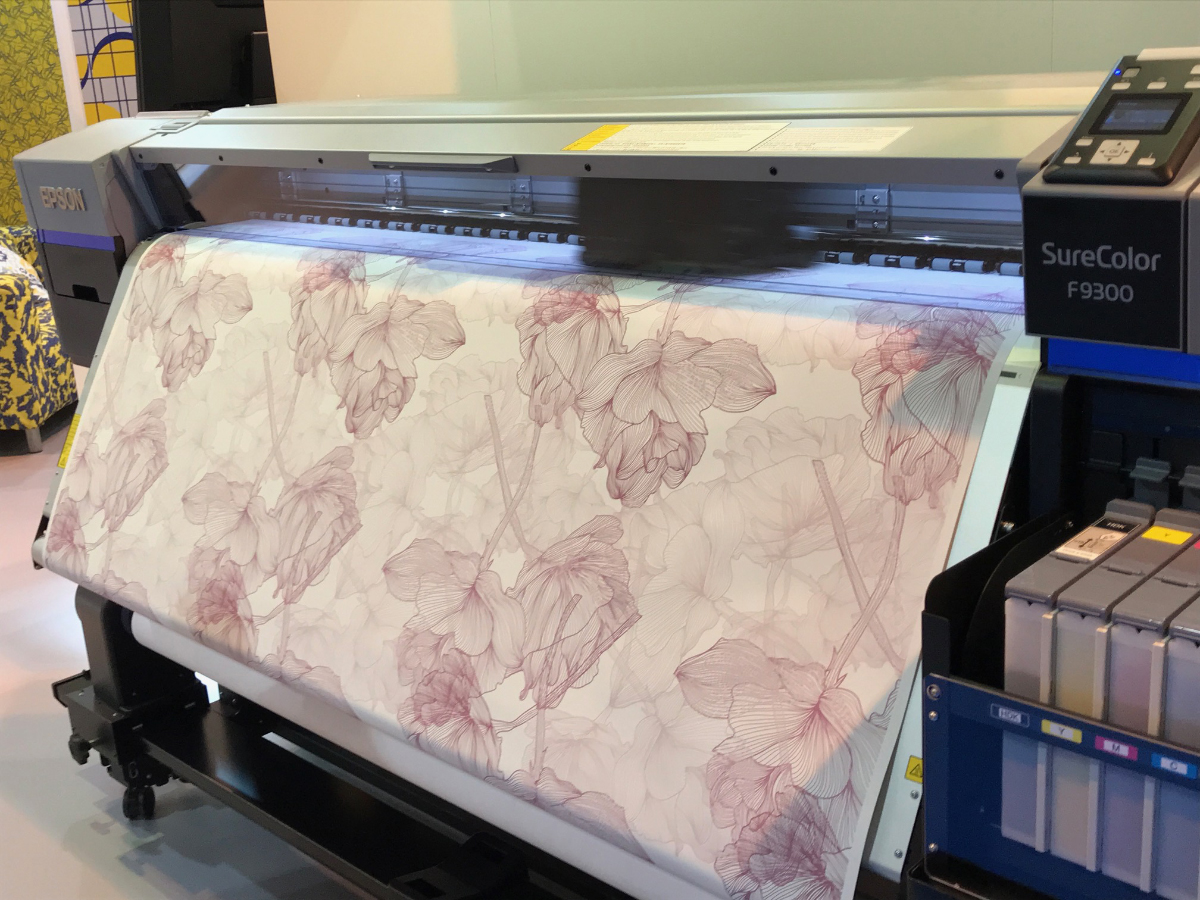
“In this Industry 4.0 era people are always looking for more intelligent systems where operators are there to confirm quality, rather than be the critical element to achieve quality,” says Epson Europe market development manager, Heather Kendle.
The SC-F2000 was on Epson’s Heimtextil stand along with the Monna Lisa Evo Tre 650m2/hr industrial textile printer and the first showing in Germany of the company’s new SureColor SC-F9300 dye-sub printer.
Kendle says the SC-F9300 is designed primarily for fast, high-volume printing for clothing, textiles and soft signage, as well as other printed merchandise.
“For the first time Epson has taken its Precision Dot technology into its dye-sub products including a halftone module, look-up tables and micro-weave, helping to make an instantly noticeable difference to print quality, and make it easy to get quality results straight out of the box.
“Furthermore, Epson’s wide gamut CMYK input profile combines with UltraChrome DS inks to ensure the maximum possible colour gamut, for accurate reproduction of even the most complex designs.
“It operates at up to 108.6m2/hr and is a completely Epson solution, comprising printer, inks and software, that maximises uptime, with improved take-up and other reliability features to eliminate common industry problems such as cockling and head strikes.”
Heimtextil served to highlight the multitude of applications that are now possible with digital textile printing and Fespa in Berlin will likely build on that in May. Textiles is set to dominate the agenda once again and the printer manufacturers will start to show their hands over the next few weeks, so watch this space closely.

